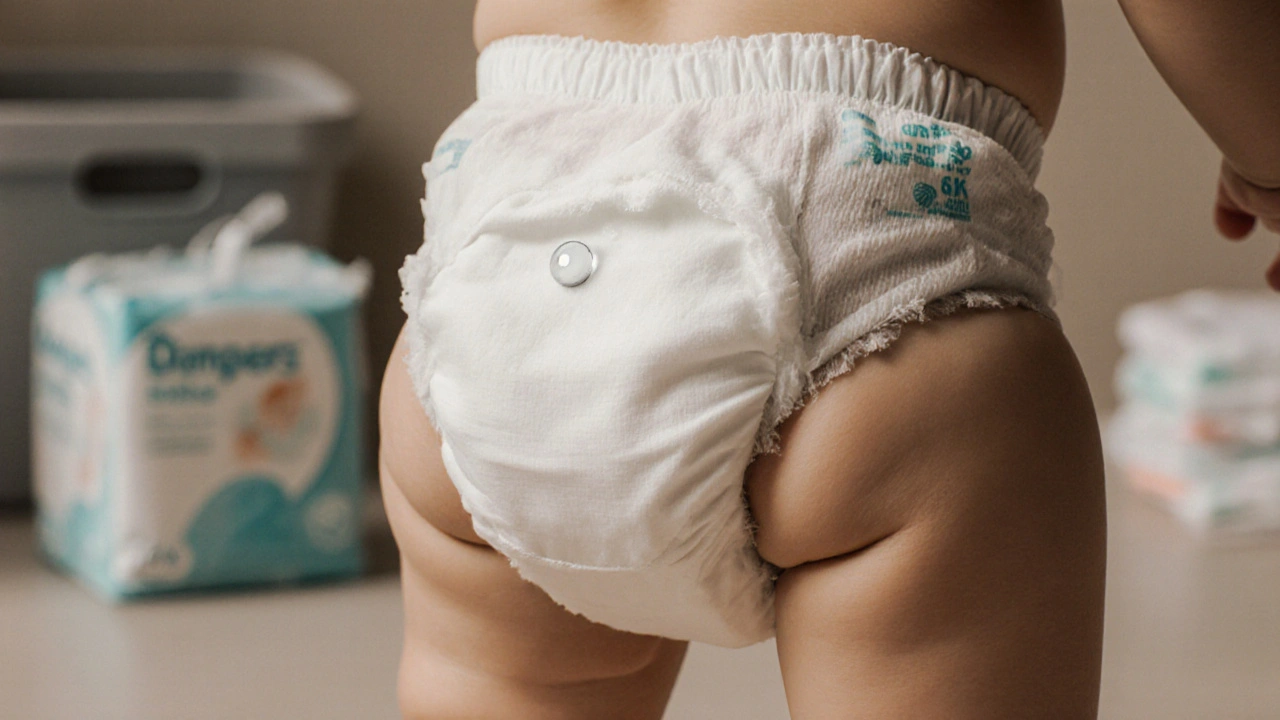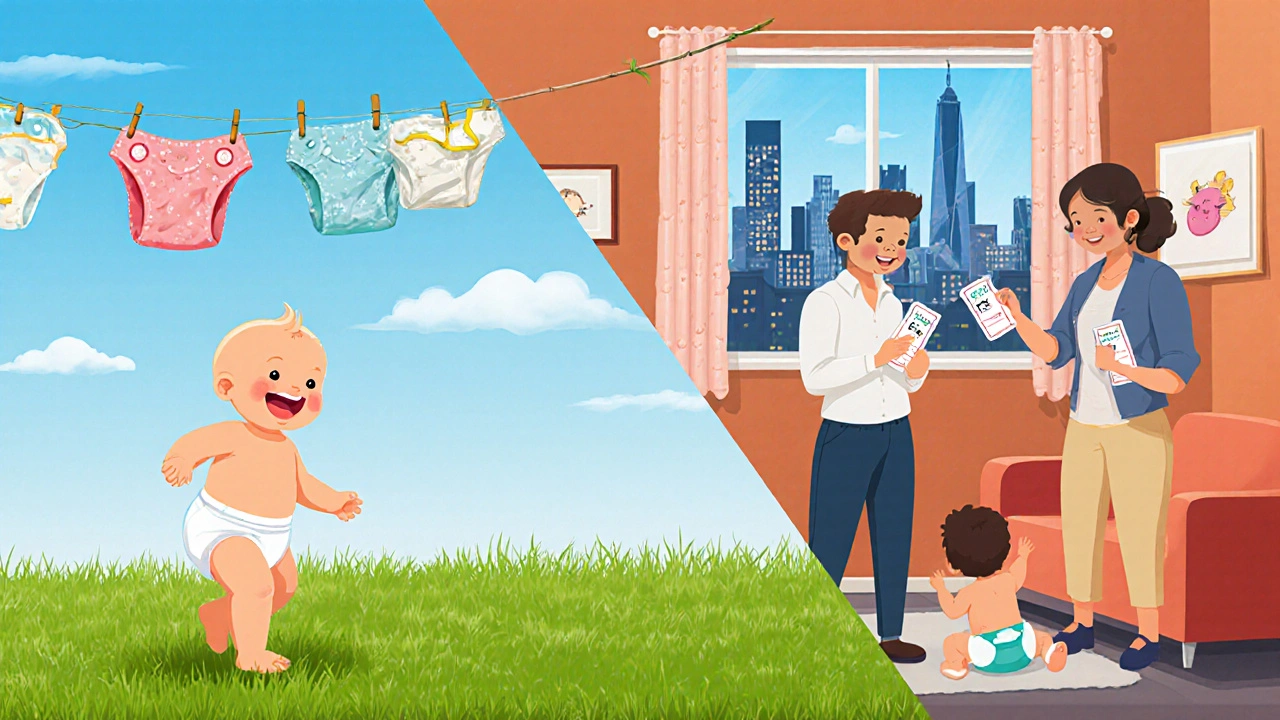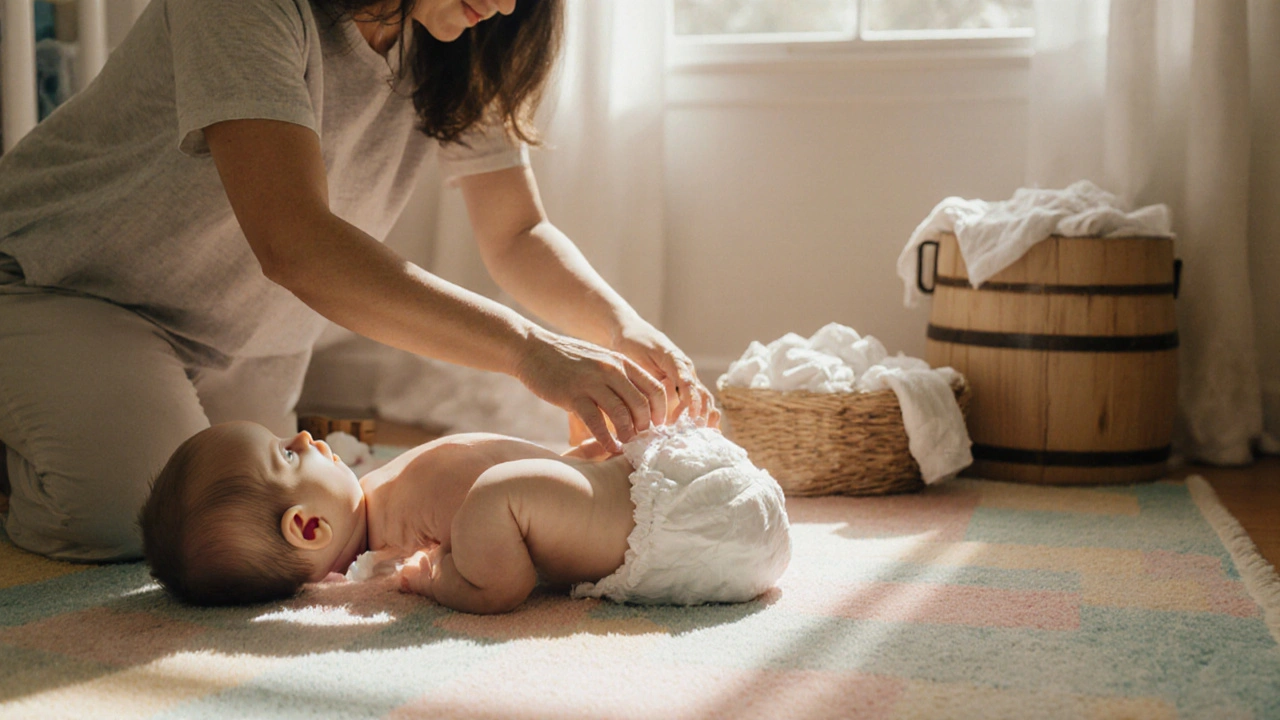Diaper rash is a painful inflammation of a baby’s skin caused by prolonged moisture, friction, and irritants. Parents often wonder whether cloth diapers or disposable diapers give the best protection. The answer hinges on how each system manages moisture, breathability, and skin‑friendly materials.
What Triggers Diaper Rash?
Three core factors drive rash formation:
- Excess moisture that softens the outer skin layer.
- Friction from a tight or bulky diaper.
- Chemical irritants such as fragrance, dyes, or the superabsorbent polymer (SAP) in many disposables.
When any of these linger for more than 10‑15 minutes, the baby’s skin pH shifts toward acidity, breaking down the natural barrier and inviting bacterial overgrowth.
How Cloth Diapers Keep Skin Calm
Cloth diapers are made primarily from natural fibers such as cotton, bamboo, or hemp. These fibers provide two key benefits:
- Breathability: Natural fibers allow air to circulate, helping evaporate sweat and keeping the diaper’s inner surface drier.
- Moisture‑wicking cotton or bamboo pulls liquid away from the skin and spreads it across the absorbent layer, reducing localized wet spots.
Because cloth diapers lack a chemical‑heavy inner liner, they usually have a neutral skin pH impact. Parents can also choose “hypoallergenic” inserts that omit latex or synthetic dyes, further minimizing irritation.
How Disposable Diapers Aim to Prevent Rash
Modern disposable diapers rely on a sandwich of three layers:
- A soft top sheet that feels like a second skin.
- A Superabsorbent polymer (SAP) core that can lock up to 300 times its weight in urine.
- A waterproof outer cover that stops leaks.
The SAP is a marvel of chemistry, but it also locks moisture against the skin for longer periods, sometimes creating a micro‑environment where the skin stays wet underneath the top sheet. Many disposables add fragrance or lotion to mask odor, yet those additives can disrupt the skin’s natural defenses.
Direct Rash‑Risk Comparison
| Factor | Cloth Diapers | Disposable Diapers |
|---|---|---|
| Moisture Management | Wicks moisture; air‑circulates | SAP holds liquid close to skin |
| Breathability | Natural fibers allow airflow | Polyethylene outer layer blocks air |
| Chemical Irritants | Usually fragrance‑free, no SAP | Fragrances, dyes, SAP chemicals |
| Wetness Indicator | Manual check needed | Color change alert |
| Cost per Use (US$) | 0.05‑0.10 (laundry) | 0.25‑0.35 (single use) |
| Environmental Impact | Reusable, lower landfill footprint | High landfill volume, carbon cost |
Studies from pediatric dermatology clinics in 2022‑2024 report a 12‑18% lower incidence of moderate‑to‑severe rash when infants wear breathable cloth systems compared with standard disposables, assuming comparable change frequency.

Practical Tips to Keep Rash at Bay No Matter the Diaper
- Change frequently. Aim for every 2‑3 hours or as soon as you see a wetness indicator.
- Give your baby a diaper‑free stretch each day. Air exposure restores the skin barrier.
- If you use cloth, add a bamboo liner for extra absorbency without sacrificing breathability.
- For disposables, pick a brand that advertises “fragrance‑free” and “pH‑balanced” to reduce chemical load.
- Apply a thin layer of a zinc‑oxide cream after each change if the skin looks red; it creates a protective barrier.
Cost, Convenience, and Eco‑Friendly Considerations
Family budgets often tip the scale. A starter kit of cloth diapers costs about $150‑$200, but after the initial outlay the per‑change cost drops dramatically. Disposable diapers can add up to $1,000‑$1,200 in the first year alone. Eco‑conscious parents cite a 75% reduction in landfill waste when switching to cloth, a figure supported by waste‑management reports from the EPA.
Decision Guide: When to Choose Cloth vs. Disposable
Use the following quick‑check matrix:
| Scenario | Best Choice |
|---|---|
| Baby has a history of sensitive skin | Cloth (breathable, chemical‑free) |
| Traveling or staying in a place without laundry facilities | Disposable (convenient, leak‑proof) |
| Family aims to lower carbon footprint | Cloth (reusable, lower waste) |
| Need a diaper that signals wetness instantly | Disposable (wetness indicator) |
Remember, the ultimate rash‑prevention factor is how often you change the diaper and keep the skin clean, regardless of the type you pick.
Related Concepts Worth Exploring
Understanding diaper rash opens doors to other skin‑care topics:
- Skin barrier function - how the outermost layer resists water loss.
- Probiotic creams - emerging products that rebalance skin microbiome.
- Hypoallergenic liners - for parents who need an extra buffer.
- pH‑balanced wipes - avoid alkaline solutions that irritate.
Future posts could dive into each of these, helping you build a complete baby‑skin care routine.

Frequently Asked Questions
Do cloth diapers cause more leaks than disposables?
Cloth diapers can be just as leak‑proof if you use a high‑quality absorbent insert and follow the manufacturer’s fit guidelines. Many modern cloth systems have a waterproof outer layer that mimics disposables.
How often should I change a cloth diaper to prevent rash?
Aim for every 2‑3 hours, or sooner if the diaper feels heavy. Changing after each feeding also helps keep moisture down.
Are there disposable brands that are rash‑friendly?
Yes. Look for labels like “fragrance‑free,” “chlorine‑free,” and “pH‑balanced.” Brands that use plant‑based SAPs and breathable outer layers tend to score better in dermatologist surveys.
Can I use a diaper rash cream with both cloth and disposable diapers?
Absolutely. A thin layer of zinc‑oxide or a pediatric‑approved barrier cream works under any diaper type. Just let the skin dry briefly before putting the diaper back on.
What’s the biggest mistake parents make that leads to diaper rash?
Leaving a wet diaper on for too long. Even the most breathable cloth can’t protect skin if it stays saturated for over 15 minutes.
Do bamboo cloth diapers reduce rash risk compared to cotton?
Bamboo fibers are naturally more moisture‑wicking and have a softer texture, which can lower friction. Studies show a modest 5‑7% reduction in mild rash cases versus standard cotton.
How do I transition from disposable to cloth without causing rash?
Start with a hybrid schedule: use cloth during daytime (when you can change often) and disposables at night. Monitor the skin and keep a gentle, fragrance‑free wipe on hand.
Is there a way to test if my baby’s skin is reacting to diaper chemicals?
Yes. Do a patch test: place a small piece of the diaper material on a clean area of skin for a few minutes, then rinse. If redness appears, consider switching to a fragrance‑free or cloth option.


It is worth emphasizing that the frequency of diaper changes remains the cornerstone of rash prevention, irrespective of whether one opts for cloth or disposable solutions. While cloth diapers excel in breathability due to natural fibers, they still require diligent monitoring to avoid prolonged moisture exposure. Conversely, disposable diapers offer a waterproof barrier that can trap humidity against the skin if not swapped promptly. Parents should therefore adopt a schedule of changing every two to three hours, or sooner when a wetness indicator signals saturation. Integrating a thin layer of zinc‑oxide cream after each change can provide an additional protective barrier. Moreover, selecting fragrance‑free and pH‑balanced options minimizes chemical irritants on delicate skin. In the broader context, environmental considerations and cost efficiency also influence the decision‑making process. Ultimately, a balanced approach-honouring both skin health and practical constraints-yields the best outcomes for infants.
Diaper rash primarily results from moisture, friction, and chemicals. Cloth diapers are breathable, but they must be changed often. Disposable diapers can trap moisture due to SAP. Changing every two to three hours reduces risk. Use fragrance‑free products when possible.
Ah, the eternal showdown-cloth versus disposables-like a Shakespearean tragedy played out in the nursery! One cannot simply dismiss the elegance of bamboo fibers, which whisper sweet nothings to a babe's skin, while the other brandishes a polymer fortress that, though mighty, may conspire with humidity. Yet, dear parents, let us not be blinded by the drama; the true hero is the vigilant caregiver who changes that diaper before the plot thickens. Remember, the stage is set for comfort, not conflict.
Bruh, that bamboo stuff really does wonders!
While the article outlines the pros and cons with commendable thoroughness, it seems to underplay the sheer inconvenience that cloth diapers can impose on a traveling family. The occasional leak is one thing, but the logistics of laundering on the road often outweigh the modest environmental gains. In my experience, a well‑chosen disposable-particularly one labeled fragrance‑free-offers a pragmatic balance between skin health and parental sanity.
One might contemplate the dialectic between nature and technology as embodied in cloth and disposable diapers respectively. The former, with its organic fibers, gestates a micro‑environment conducive to aeration, whereas the latter, a marvel of polymer chemistry, aspires to encapsulate moisture with alacrity. Yet both converge upon the singular epistemic truth: the caregiver’s attentiveness dictates the outcome.
From a systems‑optimization perspective-leveraging supply‑chain analytics, life‑cycle assessment metrics, and material‑science breakthroughs-the disposable paradigm presents a high‑throughput, low‑friction solution; however, the embedded carbon footprint, quantified in megajoules per unit, introduces a non‑trivial externality. Conversely, the cloth approach offers a closed‑loop reuse cycle, yet demands logistical coordination for launderability, which may inflame operational overheads. Ultimately, stakeholders must perform a Pareto analysis to reconcile these trade‑offs.
I love how this post balances data and practical tips. A gentle reminder to give babies some diaper‑free time each day really resonated with me-air is such a simple yet powerful healer. Also, kudos for highlighting the importance of fragrance‑free options; it’s easy to overlook those hidden irritants. Keep sharing these nuanced insights!
Statistically speaking, the marginal reduction in rash incidence for cloth versus disposable-approximately 12‑18%-is noteworthy, yet one must interrogate the underlying sample heterogeneity. Variables such as change frequency, skin pH baseline, and parental compliance can skew outcomes. Moreover, the economic analysis omits hidden costs like water usage for laundering. In sum, the data invites a more granular, multivariate exploration.
Reading this reminded me of the first time my niece developed a tiny rash; we switched to a fragrance‑free, bamboo‑lined cloth diaper and saw improvement within a day. It’s amazing how small adjustments-like a quick air‑out session-can make a big difference. Thanks for compiling such a comprehensive guide; it’s a great resource for new parents navigating these choices.
Excellent points raised above, especially regarding the pivotal role of change frequency. I would like to expand on that by considering the broader ecosystem of infant skin health. First, the skin barrier operates as a dynamic interface that can be compromised not only by moisture but also by micro‑abrasions caused by ill‑fitting diapers. Second, a proactive routine that incorporates a brief diaper‑free interval each day encourages re‑epithelialization, allowing the epidermis to restore its lipid matrix.
Third, the selection of barrier creams merits careful scrutiny; zinc‑oxide formulations provide a semi‑occlusive film that shields against irritants while permitting limited transpiration. Fourth, the pH of cleansing wipes can subtly shift the skin’s acid mantle; pH‑balanced, fragrance‑free wipes are therefore advisable.
Fifth, the material composition of the diaper itself-whether cotton, bamboo, or synthetic fibers-affects not only breathability but also the microbiome. Recent studies suggest that cultivating a diverse microbial community on the skin may confer protection against pathogenic overgrowth.
Sixth, parents should be mindful of the cumulative chemical load introduced by detergents used to launder cloth diapers. Opting for hypoallergenic, fragrance‑free laundry agents minimizes residual residues that could irritate delicate skin.
Seventh, the environmental context cannot be ignored; reducing landfill waste through cloth usage aligns with sustainable practices, yet the water and energy consumption of laundering should be balanced against that benefit.
Eighth, a systematic approach to monitoring skin condition-perhaps a simple diary noting rash episodes, diaper type, and change intervals-can empower caregivers to identify patterns and adjust strategies promptly.
In conclusion, while the article outlines the foundational factors of rash prevention, embracing a holistic, evidence‑based regimen that intertwines proper diaper choice, diligent change schedules, supportive skin care products, and mindful laundering practices will yield the most resilient outcomes for infant dermatology.
Honestly, the drama around cloth versus disposables sometimes feels overblown-like opting for a silk robe when a comfy hoodie will do. Sure, bamboo offers a sleek vibe, but the real hero is that you actually check the diaper before it becomes a swamp. If you’re not swapping every couple of hours, no amount of fancy fabric will save the skin. So, let’s cut the theatrics and stick to the basics: change often, keep it clean, and pick products without the extra chemical fireworks.